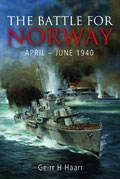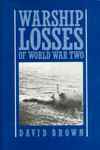The Battle for Norway
April-June 1940
Geirr H. Haarr
2010, Naval Institute Press
ISBN 159114051X
Hardcover, 480 pages
| Type. | Historical narrative |
| Pros. | Great research, very complete and detailed |
| Cons. | Might use a few more maps |
| Rating. |  |

The Battle of Norway, April - June 1940 is the second volume in Geirr H. Haarr’s work, following The German invasion of Norway, April 1940 published in 2009. This is one of those titles that grabs you right away; the weight, overall quality of the production and massive reference listing and appendices right away indicate a very serious work on the topic. As you read through the book the initial impression is strongly confirmed. Haarr’s research and presentation is first-class and being a Norwegian himself the work is clearly one of passion.
While this book does not feature U-boats very strongly they are covered and the many naval engagements are of course given plenty of room. The incredible opportunities the U-boats had to inflict crippling damage to the Royal Navy and the Army transports - only to have the torpedoes fail almost without exception - is detailed. Haarr comes to the rightful conclusion that the U-boat force was, as it turned out, almost irrelevant for the campaign in Norway. Luftwaffe, the surface fleet and the Army, in the first truly combined arms operation the world ever saw, bore the blunt of the fighting and ensured victory.
Viewpoints in the book are constantly switching from the Allied side, the Norwegians and the Germans. The Germans are, in my opinion, given a very neutral and fair assessment, they do not as a whole come through as mindless Nazi thugs as sometimes happens in books. The Norwegians had many occasions to be very bitter towards the Germans for several controversial events, mostly bombings by air but this bitterness does not pollute the work. German attempts to settle matters after the Norwegian surrender, by releasing vast majority of Norwegian Army prisoners, are explained.
Allied treatment of their Norwegian allies is another bitter point in the campaign. Time and again vital information was withheld from the Norwegians and in the end they were literally left alone when the British and French left, having misled the Norwegian defenders right up to that moment in some cases. Many Norwegians of course escaped, including the King and his ministers and also many armed forces personnel. Ships not able to escape were ordered to be destroyed but some ended up in German hands. German capture of the King and ministers failed when the heavy cruiser Blücher, carrying troops responsible for capturing vital personnel and infrastructure in Oslo, was sunk in Oslo fjord on 9 April. Eventually, as Haarr puts it, “Norway would have to be Nazified the hard way” as Norway would fight on in exile and bring its massive merchant fleet to the Allied cause.
Haarr also discusses the strategic importance of Norway, before the invasion and then the unforeseen value after the invasion of Russia in 1941.
The text is very well written and the very complicated story of the Norwegian invasion and the following battles is relatively easy to follow. I would have put a few more maps in there as the many locations and ever-changing situations are such that it takes a bit of a work to be absolutely sure you are on top of things. Usually this resolves itself quickly through the excellently written narrative and generous use photographs but a few times I was a bit lost but thankfully Norwegian names were relatively easy for me to understand.
Many have stated that this is the ultimate work on the matter and from what I’ve seen I have to agree. This is a must title for better understanding of the invasion of Norway in 1940. Highly recommended.Review written by Guðmundur Helgason.
Published on 28 Jul 2010.
This title is highly recommended.
Purchase information: (info) Get The Battle for Norway now at amazon.co.uk
Get The Battle for Norway now at amazon.co.uk
Return to our main review page.



